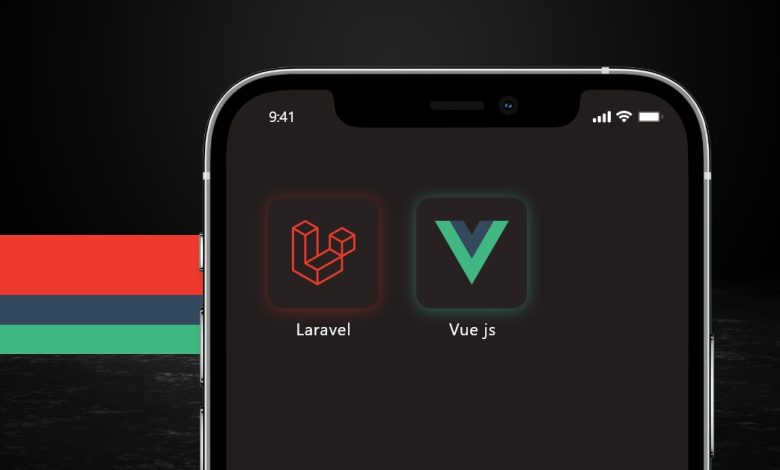
Laravel is that cousin of Vue.JS who, when they meet, always creates something out-of-the-box together. Feeling nostalgic? Despite being the two most popular frameworks on the web, this combination has been a favorite of developers since it was first introduced.
Laravel is an open-source PHP framework that developers can use to build web apps. It has a rich set of features that makes it the best choice for people who want to develop a full-stack application. There are numerous reasons why Laravel is quite welcoming to developers; it’s simple to learn, and using nature is the other two.
On the other hand, Vue.JS is an open-source JavaScript framework that allows developers to build amazing user interfaces with minimal code quickly. The JavaScript framework provides a declarative approach to building user interfaces on the web. The main advantage of using this framework is that it is fast, lightweight, scalable, and easy to use.
It is not hard to grasp why Laravel with Vue JS would be a great choice for web app development: they both have strong communities and support, and they run on different backends. Above all, they both share similar goals when it comes to user experience.
They also share similar drawbacks: although Laravel does not require additional libraries, it requires some knowledge of how Laravel works under the hood — for example, if you want to create multilingual sites, you must use the Blade templating engine instead of the Twig template engine.
That said,
Laravel and Vue.Js is a perfect combination for web app development because of their flexibility, performance, and ease of use. Still, you needed validation; that is why you searched the term Laravel and Vuej.JS combination and landed here.
I won’t disappoint you. Now, we will dig together and find out how beneficial this duo is, after all. But first, let us wrap our heads around why businesses worldwide hire Laravel developers more than anything. Get ready!
- It offers excellent reusability for existing components or frameworks;
- Has easy to learn and use functionalities;
- Produces well-structured and realistic websites;
- Accelerates the speed of your website development;
- It saves development time and effort;
- Equipped with tools and packages to make more secure and attack-resistant websites.
What is Vue.JS?
Talking about Vue.Js, Evan You, a former Google programmer, created this marvelous progressive frontend framework on top of JavaScript. The framework is widely used to develop engaging user interfaces and single-page applications. Basically, the Vue framework focuses on the view layer of the app. Thus, you can easily integrate it with various platforms as well as existing frameworks.
Vue goes beyond creating web applications. It is potent enough to develop desktop and mobile apps using the Electron framework. We can reckon the capabilities of Vue from its user base, which includes Xiaomi, Gitlab, Behance, Alibaba, and Adobe.
How come the Laravel and Vue combination is so powerful?
The mighty frontend
The UI of your application is one of the most critical aspects of your product. It not only gives users a sense of what your application is capable of but also helps you keep track of bugs and fixes.
Using the power of Vue.Js, you can create a seamless user experience and front end of your Laravel application. This will allow you to build rich and complex user interfaces that are faster to develop and easier to maintain. This will also allow you to build complex single-page applications (SPAs) that are easy to manage, update, and secure.
Reactive components for event-driven apps
You know, Vue allows you to create a full-blown event-driven application with every activity entirely handled on the frontend, right? But do you know it also comes with composable components, which you can use however you wish? Thereby, Vue blends nicely with Laravel and requires you only to make fewer trips to change UI and request data from your Laravel app. You can do all this by switching components without reloading the page.
Moreover, by triggering UI changes that are consistent on your Vue frontend, you can create a hyper-engaging user experience. The changes could be as simple as enabling editable texts or interchange components to load a video that the user requests without reloading the entire page.
Achieve Complex frontend
It goes without saying that you need to run your frontend on JavaScript if your app contains parts that require frequent updates. However, the real challenge emerges when the update frequency or data volume to track increases. Given vanilla JavaScript, jQuery, or any other JavaScript libraries without a virtual DOM cease to be instantaneously resulting in noticeable performance lags.
Nevertheless, each Vue component’s dependencies are automatically tracked during its render. So, if you create your app with Vue components, the system will actively update the exact components when there is a change in data. Consequently, the DOM uses minimal resources leading to enhanced application efficiency.
Furthermore, Vue’s compatibility with state managers, such as Redux, Vuex, and Flux, makes it excellent for sophisticated apps that need to manage data flow. At the same time, Vue’s one-way data binding model complements state management.
Single Page Application
Sometimes, traditional web applications are terrible at providing a great experience. They’re slow and painful to use. And when you add in all of the other technical debt that comes along with building an application, it’s easy to see why people are afraid to build them. Besides, they’re hard to learn, hard to maintain, and hard to scale as your project grows.
The good news is that there are alternatives to traditional web applications, and the most popular one right now is Single Page Applications (SPAs). Over the past few years, single-page applications have become the preferred web app architecture.
Single-page applications deliver powerful experiences and have the potential to unlock new ways to build online experiences. Building a single-page application with Vue.js and Laravel is a great way to accomplish your complex app without needing to tackle the full stack. Vue’s components and routing system and Laravel’s built-in authentication system make it easier to build a single-page app that’s faster to load than traditional server-side rendered apps.
Straight learning curve
Vue and Laravel both frameworks have a straight learning curve as they have well-explained and in-depth documentation. Moreover, both have supportive communities. In addition to that, Vue and Laravel offer a wide range of built-in solutions that make user experience designing painless. It may sound cliche, but Laravel has expressive and object-oriented syntax and many tools and libraries supporting the use of objects. That said, Vue and Laravel go along well and make your app development a breeze.
Are you ready to use Laravel + Vue?
According to StackShare, companies that have both Vue and Laravel in their technology stacks are Bitpanda, 9GAG, and AO.com. And thousands of more businesses are using this efficient technology together to make the most out of them. Both Vue.JS and Laravel frameworks can augment your web application’s performance and efficiency right from the development process to the page-loading speeds.
Moreover, this stack also offers extensive documentation, allowing your team to get started easily as well as a rich library of modules to execute their common tasks. Noteworthy, as both frameworks support frontend development, your software product will be performant by default. So, does your technology stack has Vue and Laravel?






